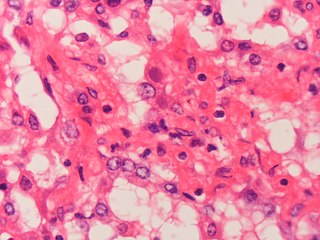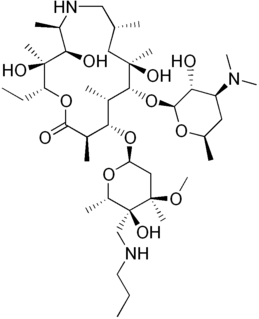
Conjunctivitis, also known as pink eye, is inflammation of the outermost layer of the white part of the eye and the inner surface of the eyelid. It makes the eye appear pink or reddish. Pain, burning, scratchiness, or itchiness may occur. The affected eye may have increased tears or be "stuck shut" in the morning. Swelling of the white part of the eye may also occur. Itching is more common in cases due to allergies. Conjunctivitis can affect one or both eyes.

Mycobacterium bovis is a slow-growing aerobic bacterium and the causative agent of tuberculosis in cattle. It is related to Mycobacterium tuberculosis, the bacterium which causes tuberculosis in humans. M. bovis can jump the species barrier and cause tuberculosis-like infection in humans and other mammals.

The Moraxellaceae are a family of Gammaproteobacteria, including a few pathogenic species. Others are harmless commensals of mammals and humans or occur in water or soil. The species are mesophilic or psychrotrophic (Psychrobacter).
Keratoconjunctivitis is inflammation ("-itis") of the cornea and conjunctiva.

Moraxella catarrhalis is a fastidious, nonmotile, Gram-negative, aerobic, oxidase-positive diplococcus that can cause infections of the respiratory system, middle ear, eye, central nervous system, and joints of humans. It causes the infection of the host cell by sticking to the host cell using trimeric autotransporter adhesins.
Streptococcus bovis is a species of Gram-positive bacteria that in humans is associated with urinary tract infections, endocarditis, sepsis, and colorectal cancer. S. gallolyticus is commonly found in the alimentary tract of cattle, sheep, and other ruminants, and may cause ruminal acidosis or feedlot bloat. It is also associated with spontaneous bacterial peritonitis, a frequent complication occurring in patients affected by cirrhosis. Equivalence with Streptococcus equinus has been contested.

Adenovirus infection is a contagious viral disease, caused by Adenoviruses, commonly resulting in a respiratory tract infection. Typical symptoms range from those of a common cold, such as nasal congestion, coryza and cough, to difficulty breathing as in pneumonia. Other general symptoms include fever, fatigue, muscle aches, headache, abdominal pain and swollen neck glands. Onset is usually two to fourteen days after exposure to the virus. A mild eye infection may occur on its own, combined with a sore throat and fever, or as a more severe adenoviral keratoconjunctivitis with a painful red eye, intolerance to light and discharge. Very young children may just have an earache. Adenovirus infection can present as a gastroenteritis with vomiting, diarrhoea and abdominal pain, with or without respiratory symptoms. However, some people have no symptoms.

Bovine malignant catarrhal fever (BMCF) is a fatal lymphoproliferative disease caused by a group of ruminant gamma herpes viruses including Alcelaphine gammaherpesvirus 1 (AlHV-1) and Ovine gammaherpesvirus 2 (OvHV-2) These viruses cause unapparent infection in their reservoir hosts, but are usually fatal in cattle and other ungulates such as deer, antelope, and buffalo. In Southern Africa the disease is known as snotsiekte, from the Afrikaans.
Moraxella is a genus of gram-negative bacteria in the family Moraxellaceae. It is named after the Swiss ophthalmologist Victor Morax. The organisms are short rods, coccobacilli, or as in the case of Moraxella catarrhalis, diplococci in morphology, with asaccharolytic, oxidase-positive, and catalase-positive properties. M. catarrhalis is the clinically most important species under this genus.
Infectious bovine keratoconjunctivitis (IBK), also known as pinkeye, New Forest eye or blight, is a veterinary infection of cattle caused by Moraxella bovis, a Gram-negative, β-haemolytic, aerobic, rod-shaped bacterium. It is spread by direct contact or by flies serving as vectors. It is the most common ocular disease of cattle. IBK is similar to human pink eye and causes severe infection of the conjunctiva, edema, corneal opacity, and ulceration. This disease is highly contagious and occurs worldwide. Younger animals are more susceptible, but recovery with minimal damage is usual, if they are treated early.
Mycobacterium caprae is a species of bacteria in the genus Mycobacterium and a member of the Mycobacterium tuberculosis complex. The species is named after the caprines, the organisms from which M. caprae was first isolated. Prior to 2003, the species was referred to as Mycobacterium tuberculosis subsp. caprae. It is also synonymous with the name Mycobacterium bovis subsp. caprae.

Musca autumnalis, the face fly or autumn housefly, is a pest of cattle and horses.

Tulathromycin, sold under the brand name Draxxin and the top generic is branded under the name Tulieve,from Norbrook Ltd., is a macrolide antibiotic used to treat bovine respiratory disease (BRD) in cattle and swine respiratory disease in pigs.

In health care facilities, isolation represents one of several measures that can be taken to implement in infection control: the prevention of communicable diseases from being transmitted from a patient to other patients, health care workers, and visitors, or from outsiders to a particular patient. Various forms of isolation exist, in some of which contact procedures are modified, and others in which the patient is kept away from all other people. In a system devised, and periodically revised, by the U.S. Centers for Disease Control and Prevention (CDC), various levels of patient isolation comprise application of one or more formally described "precaution".
Anaplasma bovis is gram negative, obligate intracellular organism, which can be found in wild and domestic ruminants, and potentially a wide variety of other species. It is one of the last species of the Family Anaplasmaceae to be formally described. It preferentially infects host monocytes, and is often diagnosed via blood smears, PCR, and ELISA. A. bovis is not currently considered zoonotic, and does not frequently cause serious clinical disease in its host. This organism is transmitted by tick vectors, so tick bite prevention is the mainstay of A. bovis control, although clinical infections can be treated with tetracyclines. This organism has a global distribution, with infections noted in many areas, including Korea, Japan, Europe, Brazil, Africa, and North America.
Pinkeye or Pink Eye may refer to:
Moraxella bovoculi is a Gram-negative bacterium in the genus Moraxella, which was isolated from the eyes of calves in Browns Valley, California. M. bovoculi can cause infectious bovine keratoconjunctivitis.
Schistosoma bovis is a two-host blood fluke, that causes intestinal schistosomiasis in ruminants in North Africa, Mediterranean Europe and the Middle East. S. bovis is mostly transmitted by Bulinus freshwater snail species. It is one of nine haematobium group species and exists in the same geographical areas as Schistosoma haematobium, with which it can hybridise. S. bovis-haematobium hybrids can infect humans, and have been reported in Senegal since 2009, and a 2013 outbreak in Corsica.








